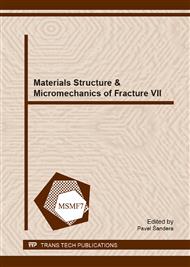p.680
p.684
p.688
p.692
p.696
p.700
p.704
p.708
p.712
High-Temperature Elastic Properties of Ceramics in the System MgO-Al2O3-SiO2 Measured by Impulse Excitation
Abstract:
Youngs moduli of talc-based ceramics from the system MgO-Al2O3-SiO2 are measured for temperatures up to 1000 °C via impulse excitation. It is shown that, after pressing at 50 MPa and firing at 1280 °C, MgO-rich compositions exhibit higher porosity and lower Youngs moduli (approximately 2030 % lower than predicted via micromechanical relations). The Young moduli of materials with less MgO decrease with temperature, but those of MgO-rich ceramics increase with temperature and exhibit a large hysteresis between heating and cooling. Lower absolute values are mainly due to increased porosity, but the reason for the modulus increase with temperature and the hysteresis is the higher enstatite content in the MgO-rich compositions. For a special composition the Youngs moduli are more or less temperature-independent and without significant hysteresis effects, probably due to the low content of enstatite and the high content of sapphirine.
Info:
Periodical:
Pages:
696-699
Citation:
Online since:
November 2013
Price:
Сopyright:
© 2014 Trans Tech Publications Ltd. All Rights Reserved
Share:
Citation:


